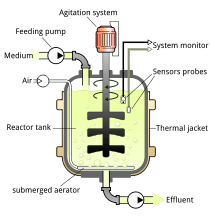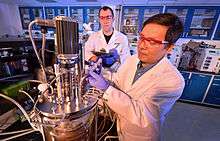Bioreactor


A bioreactor may refer to any manufactured or engineered device or system that supports a biologically active environment.[1] In one case, a bioreactor is a vessel in which a chemical process is carried out which involves organisms or biochemically active substances derived from such organisms. This process can either be aerobic or anaerobic. These bioreactors are commonly cylindrical, ranging in size from litres to cubic metres, and are often made of stainless steel.
A bioreactor may also refer to a device or system meant to grow cells or tissues in the context of cell culture. These devices are being developed for use in tissue engineering or biochemical engineering.
On the basis of mode of operation, a bioreactor may be classified as batch, fed batch or continuous (e.g. a continuous stirred-tank reactor model). An example of a continuous bioreactor is the chemostat.
Organisms growing in bioreactors may be submerged in liquid medium or may be attached to the surface of a solid medium. Submerged cultures may be suspended or immobilized. Suspension bioreactors can use a wider variety of organisms, since special attachment surfaces are not needed, and can operate at much larger scale than immobilized cultures. However, in a continuously operated process the organisms will be removed from the reactor with the effluent. Immobilization is a general term describing a wide variety of cell or particle attachment or entrapment.[2] It can be applied to basically all types of biocatalysis including enzymes, cellular organelles, animal and plant cells.[3] Immobilization is useful for continuously operated processes, since the organisms will not be removed with the reactor effluent, but is limited in scale because the microbes are only present on the surfaces of the vessel.
Large scale immobilized cell bioreactors are:
- moving media, also known as Moving Bed Biofilm Reactor (MBBR)
- packed bed
- fibrous bed
- membrane
Bioreactor design

Bioreactor design is a relatively complex engineering task, which is studied in the discipline of biochemical engineering. Under optimum conditions, the microorganisms or cells are able to perform their desired function with limited production of impurities. The environmental conditions inside the bioreactor, such as temperature, nutrient concentrations, pH, and dissolved gases (especially oxygen for aerobic fermentations) affect the growth and productivity of the organisms. The temperature of the fermentation medium is maintained by a cooling jacket, coils, or both. Particularly exothermic fermentations may require the use of external heat exchangers. Nutrients may be continuously added to the fermenter, as in a fed-batch system, or may be charged into the reactor at the beginning of fermentation. The pH of the medium is measured and adjusted with small amounts of acid or base, depending upon the fermentation. For aerobic (and some anaerobic) fermentations, reactant gases (especially oxygen) must be added to the fermentation. Since oxygen is relatively insoluble in water (the basis of nearly all fermentation media), air (or purified oxygen) must be added continuously. The action of the rising bubbles helps mix the fermentation medium and also "strips" out waste gases, such as carbon dioxide. In practice, bioreactors are often pressurized; this increases the solubility of oxygen in water. In an aerobic process, optimal oxygen transfer is sometimes the rate limiting step. Oxygen is poorly soluble in water—even less in warm fermentation broths—and is relatively scarce in air (20.95%). Oxygen transfer is usually helped by agitation, which is also needed to mix nutrients and to keep the fermentation homogeneous. Gas dispersing agitators are used to break up air bubbles and circulate them throughout the vessel.
Fouling can harm the overall efficiency of the bioreactor, especially the heat exchangers. To avoid it, the bioreactor must be easily cleaned. Interior surfaces are typically made of stainless steel for easy cleaning and sanitation. Typically bioreactors are cleaned between batches, or are designed to reduce fouling as much as possible when operated continuously. Heat transfer is an important part of bioreactor design; small vessels can be cooled with a cooling jacket, but larger vessels may require coils or an external heat exchanger.
Types of Bioreactors
Photobioreactor
A photobioreactor (PBR) is a bioreactor which incorporates some type of light source (that may be natural sunlight or artificial illumination). Virtually any translucent container could be called a PBR, however the term is more commonly used to define a closed system, as opposed to an open tank or pond. Photobioreactors are used to grow small phototrophic organisms such as cyanobacteria, algae, or moss plants.[4] These organisms use light through photosynthesis as their energy source and do not require sugars or lipids as energy source. Consequently, risk of contamination with other organisms like bacteria or fungi is lower in photobioreactors when compared to bioreactors for heterotroph organisms.
Sewage treatment
Bioreactors are also designed to treat sewage and wastewater. In the most efficient of these systems, there is a supply of a free-flowing, chemically inert medium which acts as a receptacle for the bacteria that break down the raw sewage. Examples of these bioreactors often have separate, sequential tanks and a mechanical separator or cyclone to speed the separation of water and biosolids. Aerators supply oxygen to the sewage and medium, further accelerating breakdown. Submersible mixers provide agitation in anoxic bioreactors to keep the solids in suspension and thereby ensure that the bacteria and the organic materials "meet". In the process, the liquid's Biochemical Oxygen Demand (BOD) is reduced sufficiently to render the contaminated water fit for reuse. The biosolids can be collected for further processing, or dried and used as fertilizer. An extremely simple version of a sewage bioreactor is a septic tank whereby the sewage is left in situ, with or without additional media to house bacteria. In this instance, the biosludge itself is the primary host (activated sludge) for the bacteria. Septic systems are best suited where there is sufficient landmass, and the system is not subject to flooding or overly saturated ground, and where time and efficiency are not prioritized.
Because they are the engine that drives biological wastewater treatment, it is critical to closely monitor the quantity and quality of microorganisms in bioreactors. One method for this is via 2nd Generation ATP tests.
Up and Down agitation bioreactor

Up and down agitators are useful to avoid shear stress to the cells. These are done by instead of a traditional propeller agitator, which requires an expensive motor and magnetic coupling. Vertical up and down motion is achieved by a motor together with an inexpensive membrane perfectly assure sterility and produce an efficient mixing without formation of a vortex (no baffles needed). At the same time this type of mixing is gentler on cells and produces less foam. Novel biomimicking “fish-tail” stirring discs offer maximum mixing efficiency without cutting edges.[5]
NASA tissue cloning bioreactor

In bioreactors in which the goal is to grow cells or tissues for experimental or therapeutic purposes, the design is significantly different from industrial bioreactors. Many cells and tissues, especially mammalian ones, must have a surface or other structural support in order to grow, and agitated environments are often destructive to these cell types and tissues. Higher organisms, being auxotrophic, also require highly specialized growth media.
NASA has developed a new type of bioreactor that artificially grows tissue in cell cultures. NASA's tissue bioreactor can grow heart tissue, skeletal tissue, ligaments, cancer tissue for study, and other types of tissue.[6]
For more information on artificial tissue culture, see tissue engineering.
See also
- Biotechnology
- History of biotechnology
- Industrial biotechnology
- ATP test
- Immobilized enzyme
- Biochemical engineering
- Biofuel from algae
- Biological hydrogen production (Algae)
- Bioreactor landfill
- Cell culture
- Chemostat
- Digester
- EpiBone
- Hairy root culture
- Moving Bed Biofilm Reactor (MBBR)
- Septic tank
- Tissue Engineering
- Single-use bioreactor
| Wikimedia Commons has media related to Bioreactors. |
References
- ↑ IUPAC, Compendium of Chemical Terminology, 2nd ed. (the "Gold Book") (1997). Online corrected version: (2006–) "bioreactor".
- ↑ Lopez A, Lazaro N, Marques AM. The interphase technique: a simple method of cell immobilization in gel-beads. J Microbiol Methods, 1997, 30:231-234.
- ↑ Peinado PA, Moreno JJ, Villaba JM, Gonzalez-Reyes JA, Ortega JM, Mauricio JC. A new immobilization method and their applications. Enzyme Microb Tech, 2006, 40:79-84.
- ↑ Eva L. Decker und Ralf Reski (2008): Current achievements in the production of complex biopharmaceuticals with moss bioreactor. Bioprocess and Biosystems Engineering 31, 3-9
- ↑ A non-rotational, computer-controlled suspension bioreactor for expansion of umbilical cord blood mononuclear cells, Niloufar Shayan, Marzieh Ebrahimi, Bahareh Beiki, Ehsan Janzamin
- ↑ http://science.nasa.gov/NEWHOME/headlines/msad05oct99_1.htm
Further reading
- Pauline M Doran, Bio-process Engineering Principles, Elsevier, 2nd ed., 2013 ISBN 978-0-12-220851-5
External links
|
